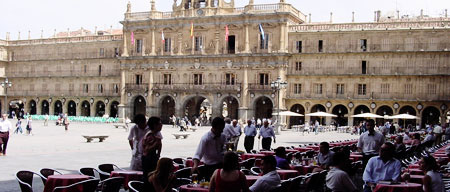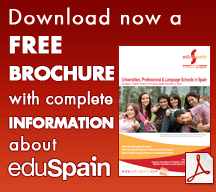Home > Study in Spain > City Guide > Salamanca
Salamanca City Guide
- Places of Interest
- Maps
- Getting to
- Getting around the city
Salamanca, situated in the west of Spain on the border with Portugal, is large enough to offer the advantages of a bustling city, while at the same time maintaining the intimacy of a town. Salmantinos speak the “purest” Spanish in Spain, as the region is known as the birthplace of Castilian, and for this reason Salamanca is enormously popular with people from all over the world who want to learn the language. Salamanca is known for its amazing architecture, all composed of the same shimmering sandstone that gave Salamanca its "Golden City" nickname. In 2002, Salamanca was appointed "Cultural Capital of Europe"; with beautiful cathedrals, old university buildings and the breathtaking Plaza Mayor, considered the most beautiful in Spain, it definitely lives up to the title.
You don’t have to arrange to meet people as the city is fairly small and you are bound to bump into friends out and about in the Plaza Mayor, one of the finest squares in Spain and known as the “living room of the Salamantinos. Salamanca is a real university city; there are Spanish students everywhere and plenty of places full of Spaniards! It is home to two grand cathedrals, spectacular Renaissance palaces, beautiful plazas and one of the oldest universities in Europe. There are plenty of opportunities to get in touch with nature too and discover the small, typically Spanish villages that are scattered about the region. Salamanca is renowned for its bustling nightlife and its fabulous array of tapas bars and restaurants, which guarantee to provide something to tickle everyone´s taste buds.
Places of Interest
The Old and New Cathedrals
Salamanca boasts two adjoining cathedrals, the Catedral Vieja and the Catedral Nueva. The most distinctive feature of the first is its High Chapel which is considered by many as the most beautiful of its kind in Spain. It contains 53 stunning panels depicting the life of Jesus Christ and the Virgin Mary, it is five stories high with eleven columns, making it quite overwhelming. The new cathedral is built in a Gothic style and is incredibly detailed and ornate. Its towers can be seen from almost anywhere in the city, and the intricate stonework of the Renaissance doorways is awe-inspiring. If you choose to climb up the tower, you will be able to walk along the roof and its balconies, both on the outside and inside of the cathedrals. The view from the top provides fantastic panoramas of Salamanca! Look for the rather out-of-place astronaut and the ice cream cone in the otherwise Renaissance and Baroque adornment around massive doors of the Catedral Nueva; sculptors brought in to restore the doorways were able to add a personal touch as a trace of his work and times.
Casa de las Conchas
Home to the public library and the regional tourist office, the Casa de las Conchas,or House of Shells, is one of Salamanca’s most striking buildings, named after the scallop shells on its façade. The building was designed by Rodrigo Arias de Maldonado, who was a Knight of the Order of Santiago. The origins of the building are unknown but it has been assumed that the shells were added as they were the most common symbol of the Order. Legend has it that one of them is made of gold! Anyone can go into the library and obtain a membership card to browse the wide selection of books or you can visit one of the library’s temporary art exhibitions.
Plaza Mayor
Designed by Alberto Churriguera and constructed between 1729 and 1755, Salamanca´s Plaza Mayor is considered to be the most beautiful in Spain. The plaza’s most impressive feature is the city hall, which is decorated with Corinthian columns and a belfry that was added in 1852. Each side of the plaza also regally displays Spain’s heroes, leaders and kings, Cervantes and Franco among them. Bullfights were held here until the 19th century, but nowadays it is simply Salamanca’s ‘living room.’ Whether you choose to take your morning coffee here on one of the many cafes terraces or meet your friends ’debajo del reloj’ (under the clock) in the evening, the Plaza is a central spot you´ll find yourself drawn to again and again.
The University
A tribute to Spanish Renaissance Art, the main building of the university is one of the city’s most important and impressive pieces of architecture. The other university buildings are spread out all over the city which is small enough to make the town feel like one big campus. The university was founded in 1218 and its most impressive feature is the façade on its main entrance. It is made of golden Villamayor stone and depicts Ferdinand and Isabel. These Catholic monarchs granted the university many privileges and the architect paid homage to them by depicting them in his work. If you can spot the frog hidden in the intricate design you shall be granted luck with your studies!
El Puente Romano
Salamanca’s Roman Bridge is thought to have been built in the 1st century AD. It is part of the Roman road that links Astoriga with Mérida and passes through the city. The bridge has 26 arches, 15 of which had to be reconstructed after devastating floods in the 17th century. At one end of the bridge there is a monument dedicated to Lazarillo de Tormes, a local fictional hero. The bridge is particularly beautiful at dusk when a stroll across it offers stunning views of the cathedral and Salamanca peeping over the city wall.
Parks
Salamanca boasts four peaceful parks within easy walking distance of the old city center.. The largest of these parks, the Parque de los Jesuitas, is famous for its lake and diverse plants. For something smaller, try the Parque de la Alamedillawhichis home to a small wildlife park and aviary. The oldest of Salamanca’s parks is the Parque de San Francisco, a haven from the pace of city life with its fountains, sculptures and unbeatable views of the university and cathedral. It is particularly popular with students during the summer months when the 600 poplars, planted in 1828, provide a shady spot to study outdoors. Finally, Salamanca's ancient city walls conceal the Huerto de Calixto y Melibea, a pretty garden of leafy trees, blooming flowers and winding pathways - ideal for a Sunday afternoon. Salamanca also offers a huge park and sports center just a short bus ride from the city center. La Aldehuela is well-equipped with football and rugby pitches, tennis and basketball courts and even an archery field, many of the facilities are free to use. From June, the outdoor swimming pool is open, complete with slides and fountains!
Maps
Getting to Salamanca
The nearest international airport to Salamanca is located to the east, in Madrid. Barajas Airport is the country's largest and busiest airport and you can fly to here from all over the world. There are eight trains per day from Madrid's Charmartin train station to Salamanca. The journey takes around 2 hours 40 minutes and costs 17€ for a single ticket. The bus company Auto Res also has 23 daily buses from Madrid to Salamanca, a comfortable express service does the journey in 2½ hours and costs 18.65€ one way, the normal service takes a bit longer and costs 12.30€. A smaller international airport is also located in Valladolid, 100km north-east of Salamanca. Direct flights with Ryanair fly from Brussels, London and Milan and other airlines fly from Paris, Alicante, Barcelona, Malaga, Seville and Valencia. Auto Res runs two buses a day from Villanubla airport to Salamanca, a single ticket costs 10.70€.
Getting around the city
Salamanca’s city center is compact enough to get about easily on foot as the majority of the historical sites are located between the Plaza and the river However, an efficient urban bus system serves the city center and the suburbs, providing a reliable and economic means of getting around, especially if you need to travel out to the bus or train station. Buses run from 7.15am until 11.45pm and there is also a night bus service which runs from midnight to 4am. A single journey costs approximately 0.90€ and can be bought directly from the driver. There is also a bus pass which saves you money on each journey, cards can be charged with €5-€30, and your credit decreases as you make journeys. They are available from the offices of the service management company and can be charged on the bus itself. Taxis also run 24 hours a day in Salamanca, taxi ranks are located all over the city center or you can order them by telephone using the radio taxi service. A journey from one side of the city to the other rarely costs more than 7€.
Renting bicycles: This is an alternative and exciting way to explore the city, and extremely cheap at just 4€ a day! Head to the shop on Calle Primero de Mayo to start your 2-wheeled adventure!
Tips
Cost of living: Salamanca is predominantly a student city and the cost of living tends to reflect this - prices tend to be lower than in Spain’s larger regional capitals. If meals in restaurants can vary from as little as 8€ for a set 3-course lunch, or menú del día, to much higher prices in Salamanca’s top restaurants. Partaking in the Spanish tradition of the tapeo, or tapas bar crawl, can also be a very reasonable way to eat and a delicious way of tasting typical Spanish cuisine. A single tapa is normally free with your drink or costs as little as 1.20€. Equally, the cost of drinks can vary enormously. A coffee taken outside on the Plaza Mayor is an unforgettable experience but can set you back anything up to 3€, whereas a coffee in a bar or cafe can cost as little as 1€. Food and drink is also available cheaply in the supermarkets, of which there are several dotted around the city center. A baguette will set you back approximately 0.60€ whilst a 1.5 liter packet of milk generally costs around 1€. The salmantino nightlife is renowned across Spain for its exuberance and the large student population ensures that every night is a fiesta. There is no entrance charge to bars and clubs and drinks can vary in price from 1€ for a small beer or shots to 5€ for a large mixer or cocktail. A student cinema ticket costs around 5€ whilst a ticket to the theater is generally priced at 18€. Entrance to museums varies between 2€ and 4€, although many museums have discounts for students and free entry on selected days. Spanish newspapers cost approximately 1.20€; however, foreign press often costs considerably more - about 3.20€ for a newspaper and more for magazines. Stamps to European destinations cost around 0.70€, whilst those to America, Asia, Africa and Oceania cost more, usually around 1€.

